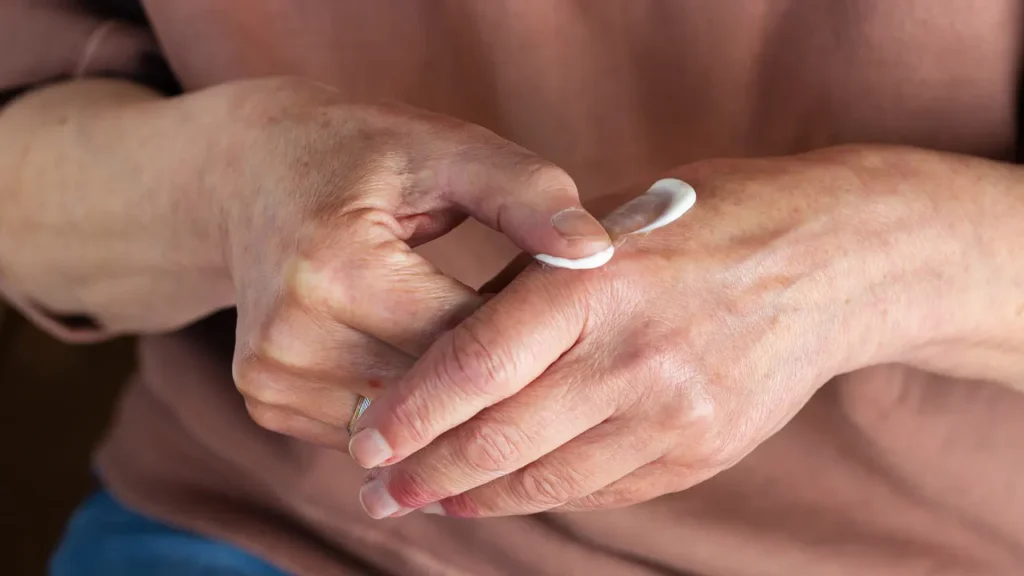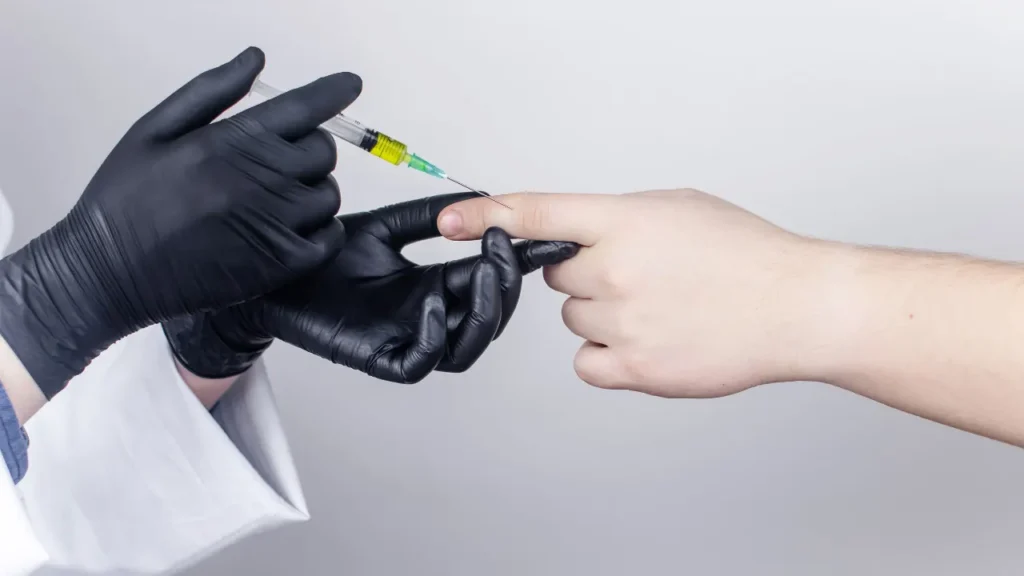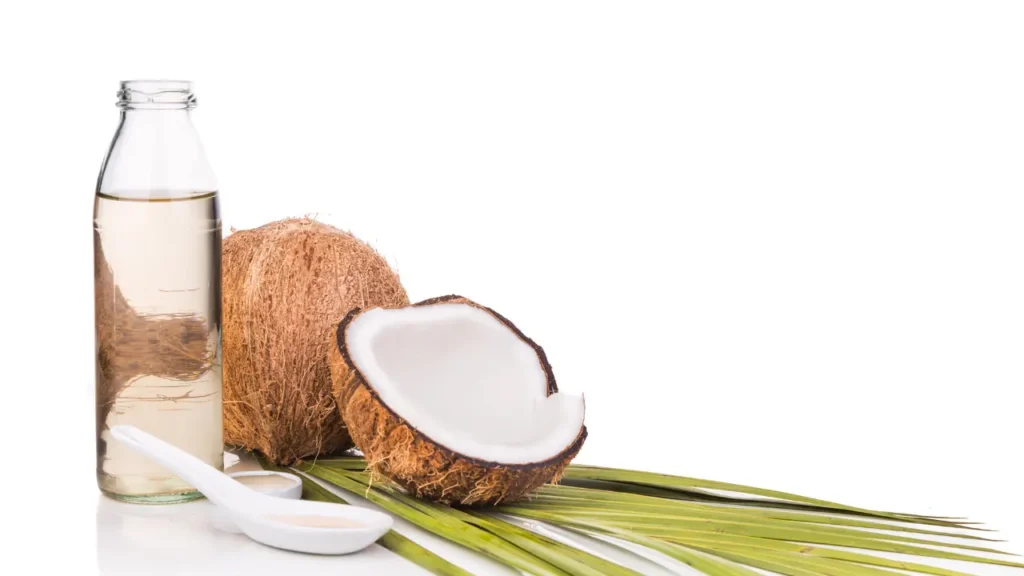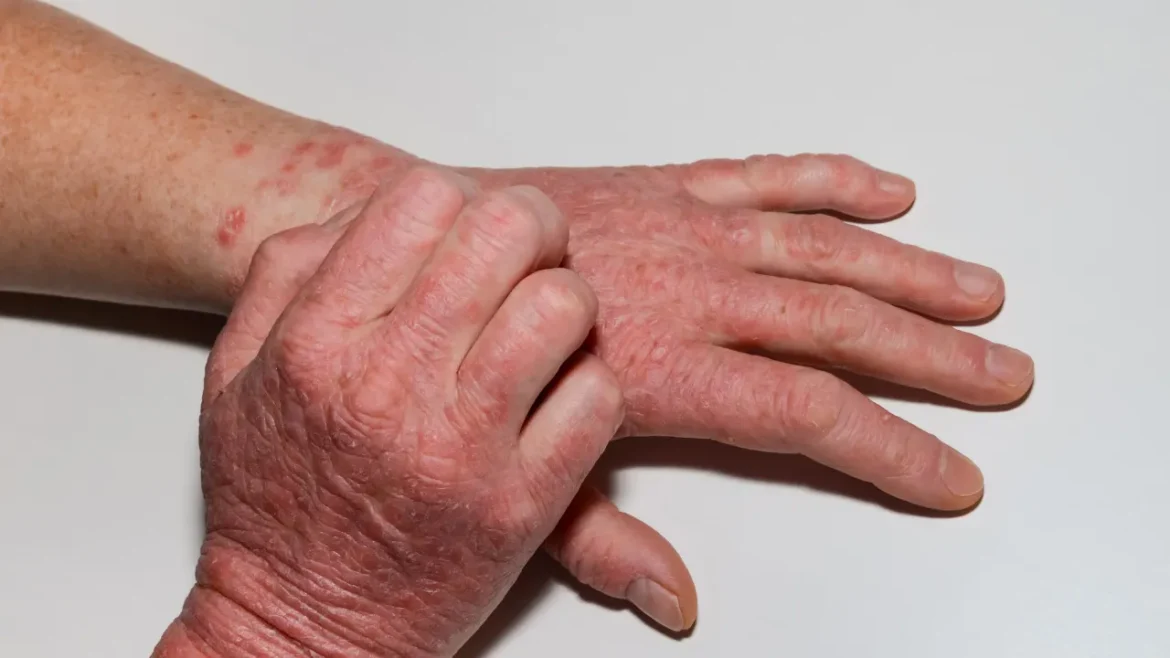Description
Small, itchy blisters filled with fluid on one’s hands and feet are a symptom of dyshidrotic eczema. The blisters tend to be accompanied by swelling, redness, and scaling and can also spread to the palms, fingers, toes, and heels of one’s feet. The blisters itch very badly and when they are hurt due to scratching or friction, they can also rupture and cause the skin to become rough. In extreme circumstances, the blisters may become infected, resulting in further complications.
You May Also Like:
MUSHROOMS FOR ATHLETES? THIS GAME-CHANGER MAY SURPRISE YOU
FINDING THE BEST TURKEY TAIL MUSHROOM POWDER: 5 TOP BRANDS REVIEWED
Dyshidrotic eczema: Description, Causes, And Treatment Protocol is an original (HealthXWire) article.
Possible Causes
Although the precise origin of dyshidrotic eczema seems unknown, a mix of hereditary and environmental factors is believed to be its main causes. The blisters may form in response to a few factors, including stress, allergies, contact with irritants, and variations in temperature. Women are more likely than men to have the illness, and those between the ages of twenty and forty are frequently affected.
Exacerbating and Mitigating Factors
Certain things can worsen or cause dyshidrotic eczema. Which involve: –
Exposure to chemicals: Chemicals like metals, solvents, and detergents are capable of irritating the skin and causing flare-ups.
Stress: Dyshidrotic eczema flare-ups and immune system deterioration can both be caused by stress.
Heat and humidity: Skin irritation and flare-ups might be brought on by hot, humid conditions.
Sweating: Excessive perspiration can aggravate the skin and bring on flare-ups.
Allergies: Flare-ups can be brought on by allergies to specific foods, like dairy or gluten, or specific metals, like nickel or cobalt.
The following constitute the mitigating factors: –
Avoiding triggers: Flare-ups may be avoided by reducing exposure to chemical exposure, stress, and allergies.
Maintaining skin moisture: Preventing dryness and skin cracking as they can lead to flare-ups.
Utilizing gentle, scent-free products: The use of gentle, fragrance-free items like moisturizers and soaps may help to reduce irritability and flare-ups.

Standard Treatment Protocols
The following is the typical dyshidrotic eczema treatment regimen: –
- Topical corticosteroids
To relieve swelling and itching, these medicines are rubbed directly into the skin’s afflicted regions. They come in a variety of formulas and intensities, from mild to strong. To prevent negative side effects like skin thinning, discoloration, and a higher possibility of infections, topical corticosteroids ought to be utilized only as prescribed by a healthcare expert and for a short period of time.
- Antihistamines
Antihistamines may be administered to reduce dyshidrotic eczema-related irritation. They function by preventing the secretion of histamine, a substance that contributes to inflammation and irritation. Both prescription and nonprescription versions of antihistamines are marketed.
- Topical calcineurin inhibitors
Another alternative for addressing dyshidrotic eczema is topical calcineurin inhibitors. These function by preventing the immunological reaction that results in itchiness and inflammation. The formulations of topical calcineurin inhibitors include cream and ointment.
- Topical immunomodulators
These drugs function by reducing the immunological response that results in skin irritation and inflammation. They come in ointment or cream form which are commonly applied to mild to moderate dyshidrotic eczema conditions. To prevent adverse effects including burning, and stinging, along with an elevated risk of infections, topical immunomodulators must be utilized only as prescribed by a healthcare provider and within a short timeframe.
- Moisturizers
Skin that is dry, damaged, or prone to flare-ups may benefit from moisturizers. It is crucial to apply a non-irritating, fragrance-free moisturizer. People should seek out products with hyaluronic acid, ceramides, and petrolatum since these components aid in sealing in moisture and repairing the skin barrier.
- Avoiding triggers
Flare-ups can be avoided by avoiding triggers like stress, chemical exposures, and allergies. If you have identified certain triggers that exacerbate your dyshidrotic eczema, take steps to avoid them. Individuals should take precautions to stay away from triggers whenever they have found any of those that worsen their conditions.
- Wet dressings
In order to reduce itchiness and irritation, cool, wet dressings are applied to the skin’s afflicted regions. In addition to protecting and hydrating the skin, wet dressings may be particularly beneficial in situations of acute dyshidrotic eczema.
- Phototherapy
Exposing the afflicted area to ultraviolet light can help with inflammation and itching. In certain instances of dyshidrotic eczema, phototherapy may serve as a useful treatment, but owing to the possibility of skin damage alongside a higher probability of skin cancer, it is best performed under medical supervision.

Treatment Options
The following are a few additional treatment methods that may be useful in controlling dyshidrotic eczema alongside standard therapy protocols: –
Nutritional Supplements: A few nutritional supplements could prove beneficial in controlling dyshidrotic eczema along with topical therapies and pharmaceutical drugs. Nevertheless, it is essential to remember that dietary supplements ought not to be utilized in place of standard medical care and people should always speak with a healthcare professional before beginning a new supplement regime. The following are some such supplements: –
- Omega-3 Fatty Acids
Essential fats known as omega-3 fatty acids have been found to possess anti-inflammatory effects. Omega-3 fatty acid supplements have been shown in studies to decrease inflammation and improve the signs of various inflammatory skin disorders, including eczema. Fatty seafood like tuna and salmon along with fish oil supplements are excellent providers of omega-3s.
- Probiotics
Probiotics are good bacteria that thrive within the gut and are essential for the immune system. According to research, taking probiotic supplements may relieve eczema symptoms by strengthening the immune system. Probiotics were beneficial in lowering the symptoms of eczema in children and adults, according to a study.
- Vitamin D
A crucial mineral for health in general, notably skin health, is vitamin D. A lack of vitamin D has been linked in studies to an elevated probability of eczema. Vitamin D supplementation may help to lessen inflammation and relieve eczema symptoms. Nevertheless, it is crucial to remember that taking too much vitamin D supplementation is dangerous, thus it is crucial to speak with a healthcare professional before consuming any supplements.
- Zinc
The immune system and the health of the skin both benefit from zinc supplementation. According to studies, people with eczema might have decreased zinc levels than people without the condition. Taking zinc supplements may help boost the immune system and decrease inflammation within the body. Nevertheless, consuming too much zinc can have negative effects, hence it is vital to speak with a doctor before consuming any supplements.
- B Vitamins
B vitamins, such as vitamin B6 and vitamin B12, play an essential role in the health of the skin and the immune system. According to studies, folks who have eczema might have a lower concentration of these vitamins than those who do not. B vitamin supplements may assist in minimizing inflammation and promoting healthy skin. Still, taking too many B vitamin pills can be hazardous, hence why it is crucial to consult the doctor before consuming any supplements.
Natural and Herbal Remedies: Certain natural and herbal treatments could prove helpful as supplemental therapy for controlling dyshidrotic eczema besides conventional medicines and supplements. For example: –
- Aloe vera
Eczema is one of many skin disorders for which aloe vera serves as a popular natural treatment. It can provide relief for itchy and dry skin because of its anti-inflammatory and hydrating qualities.
- Coconut oil
Natural emollient coconut oil may help moisturize and protect one’s skin. It also possesses antibacterial and anti-inflammatory qualities that may help prevent infections while decreasing inflammation. After taking a shower or as needed during the day, coconut oil is applied to the affected regions.
- Evening primrose oil
Gamma-linolenic acid (GLA), which is a form of omega-6 fatty acid extracted from evening primrose oil, has been demonstrated to lower inflammation and enhance the function of the skin barrier. Supplements containing evening primrose oil might be ingested or rubbed topically to the afflicted regions.
- Chamomile
Creams or lotions containing chamomile extract can be used on affected regions.
- Licorice root
The antioxidant and anti-inflammatory qualities of licorice root may help in decreasing inflammation and encourage skin healing. To treat the affected regions, patients can either make licorice tea or use it topically as lotions or creams.
- Tea tree oil
Due to its antibacterial and anti-inflammatory characteristics, tea tree oil may assist with treating inflammation and preventing infections. It needs to be used cautiously though, as certain individuals may find it irritating.
- Oatmeal
Natural anti-inflammatory oatmeal may calm irritated, itching skin. In addition to using creams and lotions containing colloidal oatmeal, individuals can also mix oatmeal into their bathwater.
It is crucial to understand that traditional medical therapies for dyshidrotic eczema cannot be replaced by natural or herbal medicines. Before beginning any new medication, it is always important to seek medical advice, particularly when the patient has previous experiences of allergies or intolerance to specific substances.

Conclusion
Dyshidrotic eczema is marked by itchy fluid-filled blisters on the hands and feet. Although the exact cause remains unclear, a way to maintain the condition is to maintain optimal skin hydration, avoid potential irritants, and manage stress. Aside from that, topical steroids and emollients are often prescribed to alleviate symptoms, while more severe cases may require oral medications. Patients should have regular follow-ups with dermatologists to help monitor progress and adjust treatment plans as needed. Dyshidrotic eczema can be considered a chronic condition that requires ongoing self-care and a collaborative relationship between patients and healthcare providers. Thus, patients must always stay informed about the triggers and seek timely professional guidance to effectively manage dyshidrotic eczema.

Additional resources for further reference
https://www.aad.org/public/diseases/eczema/types/dyshidrotic-eczema
https://my.clevelandclinic.org/health/diseases/17728-dyshidrotic-eczema
https://www.cedars-sinai.org/health-library/diseases-and-conditions/d/dyshidrotic-eczema.html
Important Note: The information contained in this article is for general informational purposes only, and should not be construed as health or medical advice, nor is it intended to diagnose, prevent, treat, or cure any disease or health condition. Before embarking on any diet, fitness regimen, or program of nutritional supplementation, it is advisable to consult your healthcare professional in order to determine its safety and probable efficacy in terms of your individual state of health.
Regarding Nutritional Supplements Or Other Non-Prescription Health Products: If any nutritional supplements or other non-prescription health products are mentioned in the foregoing article, any claims or statements made about them have not been evaluated by the U.S. Food and Drug Administration, and such nutritional supplements or other health products are not intended to diagnose, treat, cure, or prevent any disease.
Table of Contents


